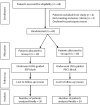Pectoral nerve versus erector spinae block for breast surgeries: A randomised controlled trial
- PMID: 31462806
- PMCID: PMC6691635
- DOI: 10.4103/ija.IJA_163_19
Pectoral nerve versus erector spinae block for breast surgeries: A randomised controlled trial
Abstract
Background and aims: Patients undergoing breast cancer surgeries face significant post-operative pain. We aimed to compare pectoral nerve (PECS) block with erector spinae (ESP) block in these patients in terms of analgesic efficacy and adverse effects.
Methods: Sixty four American Society of Anesthesiologists' status I and II female patients between age 18 to 60 years scheduled for unilateral modified radical mastectomy (MRM) under general anaesthesia, were enrolled in this prospective randomised study. Patients in group I received ultrasound guided (USG) ESP block (20 cc 0.2% ropivacaine) while group II received USG guided PECS II block (25 cc 0.2% ropivacaine). General anaesthesia was administered in a standardised manner to both the groups. The various parameters observed included sensory blockade, duration of analgesia and any adverse effects. The primary outcome was the total morphine consumption in 24 hours.
Results: The total morphine consumption in 24 hours was less in group II (4.40 ± 0.94 mg), compared to group I (6.59 ± 1.35 mg; P = 0.000). The mean duration of analgesia in patients of group II was 7.26 ± 0.69 hours while that in the group I was 5.87 ± 1. 47 hours (P value = 0.001). 26 patients in group II (PECS) had blockade of T2 as compared to only 10 patients in group I. (P value = 0.00). There was no incidence of adverse effects in either group.
Conclusion: PECS II block is a more effective block when compared to ESP block in patients of MRM in terms of postoperative analgesia and opioid consumption.
Keywords: Analgesia; erector spinae block; modified radical mastectomy; pectoral block.
Conflict of interest statement
There are no conflicts of interest.
Figures
References
-
- Schnabel A, Reichl SU, Kranke P, Pogatzki-Zahn EM, Zahn PK. Efficacy and safety of paravertebral blocks in breast surgery: A meta-analysis of randomized controlled trials. Br J Anaesth. 2010;105:842–52. - PubMed
-
- Blanco R, Fajardo M, Parras Maldonado T. Ultrasound description of Pecs II (modified Pecs I): A novel approach to breast surgery. Rev Esp Anestesiol Reanim. 2012;59:470–5. - PubMed
-
- Forero M, Adhikary SD, Lopez H, Tsui C, Chin KJ. The erector spinae plane block: A novel analgesic technique in thoracic neuropathic pain. Reg Anesth Pain Med. 2016;41:621–7. - PubMed
-
- Bashandy GM, Abbas DN. Pectoral nerves I and II blocks in multimodal analgesia for breast cancer surgery: A randomized clinical trial. Reg Anesth Pain Med. 2015;40:68–74. - PubMed
LinkOut - more resources
Full Text Sources
Medical




